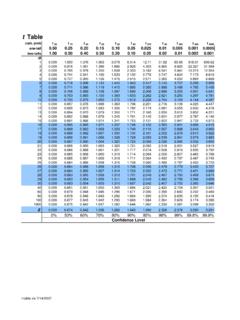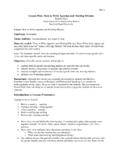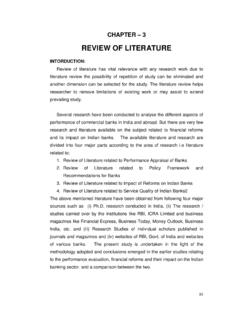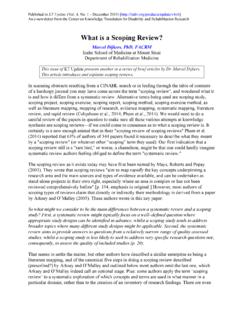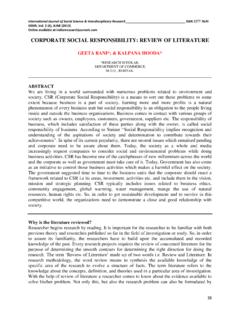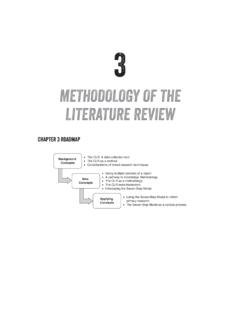Transcription of II. Review of Literature - Powering Silicon Valley
1 Literature Review 1 Natasha Hebela URBP 298 Assignment # 4 I. Introduction The Literature Review will provide an overview of Literature that has been written on the issue of gentrification. Ultimately, the objective of the Review is to acquaint readers with the various aspects of this subject matter by first showing how the research contained in this report can add value to policy makers and communities dealing with gentrification. The Review will address main themes and debates within gentrification research.
2 In doing so, the Review will also highlight specific areas where additional research is needed, specifically addressing how the research proposed for this paper can add value. Next, by using existing Literature the Review will then show how the findings support or contradict the hypothesis for this research. The proposed research methods will then be discussed, drawing upon the strengths and weaknesses used by existing studies. II. Review of Literature A. How Can Additional Research Provide Value? In the 1940s and 50s, middle-class households started leaving the city in search of a better life in the suburbs.
3 By the 1960s this left many central cities populated with high concentrations of poor, oftentimes minority households. As property values dropped, many municipalities were faced with declining tax revenues and rising social service costs. Urban renewal programs became the federal government s solution to the problem as ghettos emerged across the nation. In general, these programs did more harm than good to central city communities, leaving urban communities scarred and distrustful of any kind of revitalization effort. In the 1970s, a more organic form of urban renewal began to emerge gentrification.
4 The national economic shift from manufacturing to services meant that many working-class residents employed by blue-collar jobs were now in low paying service positions. At the same time, white-collar professionals were on the rise. The decline of familsm, the increasing number of professionals without children, and the desire for a reduced commuting time lead many of these professionals to choose to reside in the urban core instead of the suburbs. Thus gentrification was different from traditional urban renewal in that it was initiated by the private For central cities, the gentrification process meant a 1 David Melchert, and Joel L.
5 Naroff, Central City Revitalization: A Predictive Model, AREUEA Journal 15, no. 1 (1987): 664. Literature Review 2 return of tax-generating middle-class residents to the It also signaled an opportunity for racial and economic integration. Middle-class pioneers looking for cheap buildings with architectural appeal purchased and restored properties in central city communities for use as their primary This restoration triggered risk-averse individuals and investors to consider central city communities as viable areas for revitalization.
6 Unfortunately, these investors and realtors did not always have the best interest of existing neighborhood residents in mind. Some realtors actively encouraged more of their own kind to move into a neighborhood by buying properties cheaply and then turning around and selling them for a large Investors have also been known to engage in questionable business practices, threatening individuals who refuse to sell their properties in gentrifying communities. While these are some of the more extreme situations, there are many stories of people who find themselves displaced by gentrification.
7 Prices are eventually bid up such that low-income renters and owners cannot compete with middle- and upper middle-income individuals. Many rental units are converted to ownership properties, and existing property owners often cannot afford the increase in property taxes and are forced to move elsewhere. It has become apparent that uncontrolled gentrification could have negative consequences for existing residents, namely displacement and a reconcentration of lower-income individuals in specific parts of the While gentrification holds the potential to benefit communities, the potential downsides have lead many theorists to contend that a public/ private partnership that channels the benefits generated from gentrification to the areas where community services could be more effectively and efficiently provided.
8 While at the same time controlling the intensity and minimizing the disruptive neighborhood changes generated by gentrification is For those residents who do remain in the neighborhood, there is often a cultural conflict between new and old residents. This conflict varies in its nature, but is often rooted in a combination of racial and class struggles. Sometimes, new and existing residents have differing beliefs about what type of behavior is acceptable or unacceptable. In some neighborhoods this has resulted in new residents complaining to the police things such as residents hanging out on the sidewalk.
9 Interestingly, many gentry cite the diversity of their neighborhood as an attractive and distinctive At the same time, many existing residents feel alienated from their new neighbors and indicate that they experience increased harassment from law enforcement trying to keep the newer neighbors feeling safe. 2 Ibid., 665. 3 John J. Betancur, Isabel Domeyko, and Patricia A. Wright, Gentrification in West Town: Contested Ground (Chicago: University of Chicago, Nathalie P. Voorhees Center for Neighborhood and Community Improvement, 2001), 11. 4 Ibid., 12. 5 Melchert, 665.
10 6 Ibid. 7 Betancur et al., 38. Literature Review 3 Many of the newer residents are also less involved in neighborhood organizations. As a result, many lack the opportunity to get to know their neighbors. In neighborhoods that do have strong neighborhood associations or community development corporations, gentrifying neighborhoods have been more successful at combating the negative aspects of gentrification. A NeighborWorks study found that neighborhood residents in Boston s Jamaica Plain and s Shaw felt the gentrification that was taking place in their neighborhood to be an overall positive Neighborhood organizations in Atlanta s Reynoldstown neighborhood also mobilized against some gentrification efforts in their neighborhood to ensure that what was taking place was more in line with the residents vision of the In addition to neighborhood organizations, CDCs have also been involved in mitigating the negative effects of gentrification.

